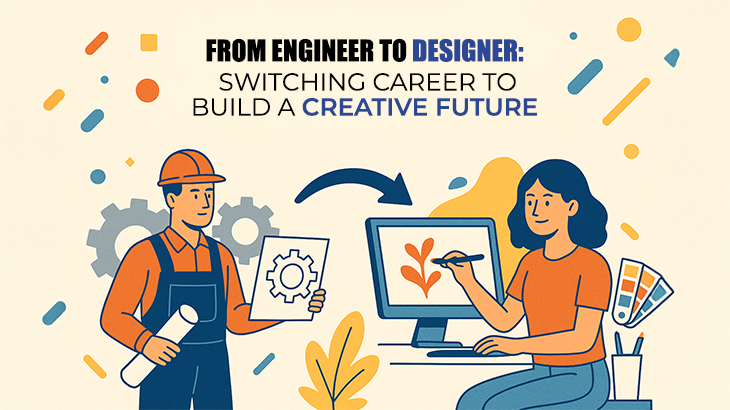Engineering teaches you to think in systems, solve problems, and work within a framework of logic. Design, on the other hand, invites you to imagine, question, and create beyond boundaries. At first glance, the two may seem worlds apart. Yet, in today’s dynamic industries, an engineer’s structured thinking combined with a designer’s creative approach is a powerful combination. Many professionals are now choosing to step away from purely technical roles and embrace a creative career path—one that offers both personal fulfillment and the opportunity to shape a more innovative future.
Why Engineers Make Great Designers
An engineer’s foundation is rooted in problem-solving, analytical thinking, and understanding how things work—skills that translate beautifully into the design world. Whether you’re designing a piece of jewellery, crafting a garment, creating interiors, or developing digital experiences, the ability to analyse challenges, break them down into manageable steps, and find innovative solutions is invaluable.

For example, in fashion or jewellery design, technical precision matters just as much as aesthetics. In interior design, spatial planning requires logic alongside creativity. In digital design, a structured approach can help in creating user-friendly and visually appealing interfaces. Engineers already have a natural advantage here—the discipline to refine processes and the patience to test and improve ideas.
Recognizing the Desire for Change
The decision to switch careers often starts as a quiet thought: “What if I could do something more creative?” For many engineers, this thought grows stronger when their current role starts to feel limiting. Maybe you’ve always sketched in the margins of your notebook, enjoyed working on DIY projects, or spent hours exploring design trends online. Over time, these interests can outweigh the satisfaction you get from purely technical tasks.
Recognising this desire is the first step. The second is believing that your engineering background is not a barrier—it’s an asset.
Finding the Right Design Path
Design is not a single discipline; it’s a universe of possibilities. If you’re drawn to fashion, you can channel your precision into pattern-making or textile innovation. If interiors inspire you, your analytical skills can help you create spaces that balance functionality and beauty. If your interest lies in visual storytelling, communication or digital design can be your arena to combine technical tools with creative vision. And if jewellery excites you, your eye for detail and precision can help you craft timeless, wearable art.
The Role of Education in Transitioning
Switching careers isn’t just about passion—it’s about equipping yourself with the right skills and exposure. Formal design education bridges the gap between technical expertise and creative expression, helping you translate ideas into impactful outcomes. Institutions like ARCH College of Design & Business
offer an environment where industry knowledge, cultural understanding, and innovation come together.
At ARCH, working professionals can restart their design journey with Master’s degree in design and entrepreneurship, in disciplines including Fashion Design, Interior Design, Design Communication and Jewellery Design.
https://www.youtube.com/watch?v=mk_Sdxx8ofQ
For those with entrepreneurial ambitions, the college’s ecosystem offers mentorship, industry connections, and hands-on learning that equips you to start your own design venture. Through live projects, collaborations with artisans, and participation in exhibitions, students gain both creative skills and business acumen—making the transition into the design world not just possible, but empowering.
Design students at ARCH work on live projects, collaborate with industry professionals, and engage in cultural and community-based initiatives that expand their creative perspectives. For someone coming from an engineering background, this immersive learning environment makes it easier to adapt to the design mindset while leveraging existing strengths.
Overcoming Challenges in Career Switching
It’s natural to feel hesitant about starting over. Questions about financial stability, learning curves, and peer perception can make the transition daunting. However, the design field values diverse perspectives, and your engineering background gives you a unique voice. At ARCH, mentorship and peer learning provide the support needed to navigate these challenges. The focus is not just on skill-building but on confidence-building, so you feel prepared to enter the industry with a fresh, adaptable approach.
During ARCH’s Design Culture learning Series session, Sudha Chandani Khatri mentioned her journey of transition from being an engineer to a photographer.
“For me, the transition was very organic and that’s way I tell everybody, it’s not that you have to leave everything to follow your passion. That is one approach. The other approaches you can be where you are, and you will be able to find time for your passion. And you can gradually transition, and you will not even feel the heat of that transition.”
Read more from Sudha Chandani Khatri’s session.
The Rewards of Following Your Passion
Making the shift from engineering to design opens up a career filled with possibilities. You get to work on projects that not only challenge your creativity but also leave a lasting impact on people’s lives. The joy of seeing your ideas take shape—whether in the form of a garment, a brand identity, a home interior, or a piece of jewellery—brings a sense of fulfilment that purely technical roles often lack.
More importantly, you join a community of creators, thinkers, and innovators. At ARCH, this community extends beyond the classroom, with opportunities to participate in exhibitions, competitions, and international exchange programs that broaden your horizons.

Your Creative Future Awaits
Switching from engineering to design is not about starting from scratch—it’s about building on what you already know and adding a new layer of creativity. If you’ve ever felt the pull towards a more imaginative, expressive career, now is the time to explore it. With the right guidance, practical training, and supportive learning environment, you can turn your technical expertise into a creative force that shapes the future.
At ARCH College of Design & Business, we believe that innovation blooms at the intersection of logic and imagination. If you’re ready to make the leap, your creative future is waiting.
